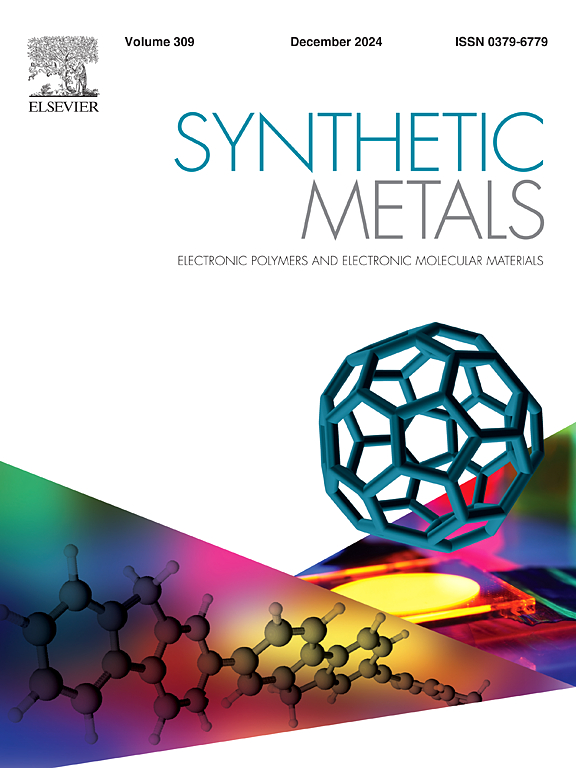电接重氮层增强聚吡咯薄膜的附着力
IF 4.6
3区 材料科学
Q2 MATERIALS SCIENCE, MULTIDISCIPLINARY
引用次数: 0
摘要
对于导电聚合物薄膜来说,在从柔性电子到传感器的广泛应用中,很好地粘附在基板上,以确保稳定性、耐用性和最佳性能是至关重要的。在苯胺和4-(1 h -吡咯-1-基)苯胺水溶液中,采用重氮电还原法分别在FTO表面电接苯基(Bz/FTO)和4-(1 h -吡咯-1-基)苯基(BzPy/FTO)单层。电化学实验证明了电接层对FTO表面的功能化作用,并估计了表面阻滞率,达到99% %以上。将聚吡咯薄膜成功电沉积在接枝苯基(PPy/Bz/FTO)或4-(1 h -吡咯-1-基)苯基(PPy/BzPy/FTO)上。测定了这些薄膜的形貌、电导率、电活性和刚度,并与聚吡咯在裸FTO表面电沉积的薄膜(PPy/FTO)进行了比较。结果表明,这两种薄膜的电活性相当相似,而在电接FTO表面上电沉积的PPy薄膜的电导率比在裸FTO衬底上电沉积的薄膜低3倍,但附着力更强(47-48 nN比33 nN)。通过水浸泡和干燥测试,证实了电接FTO上的PPy薄膜具有很强的附着力,因为它们不会分层,而生长在裸FTO衬底上的PPy薄膜会脱落。因此,电接层的使用使得获得在水中更粘附的PPy薄膜成为可能,因此在水介质(如传感器、能量存储或软机器人)中的应用可能更有趣。本文章由计算机程序翻译,如有差异,请以英文原文为准。
Strengthening adhesion of polypyrrole films by electrografting of diazonium layers
It is crucial for conductive polymer thin films to adhere well to the substrate to ensure stability, durability, and optimal performance in a wide range of applications, from flexible electronics to sensors. In this work, electrografting of phenyl (Bz/FTO) and 4-(1 H-pyrrol-1-yl)phenyl (BzPy/FTO) monolayers on FTO surface was performed in aqueous solution of aniline and 4-(1 H-pyrrol-1-yl)aniline, respectively, using the diazonium electroreduction method. Electrochemical experiments were used to demonstrate the functionalization of the FTO surface by the electrografted layer and to estimate the surface blocking rate, which reached over 99 %. A polypyrrole film was then successfully electrodeposited onto electrografted phenyl (PPy/Bz/FTO) or 4-(1 H-pyrrol-1-yl)phenyl (PPy/BzPy/FTO). The morphology, conductivity, electroactivity and stiffness of these films were determined and compared with those of polypyrrole electrodeposited on bare FTO surfaces (PPy/FTO). The electroactivity was found to be fairly similar for each of these films, while the PPy films electrodeposited on electrografted FTO surfaces showed three times lower conductivity than those electrodeposited on bare FTO substrates but stronger adhesion (47–48 nN against 33 nN). The very strong adhesion of the PPy films on electrografted FTO was confirmed by water immersion and drying tests, as they did not delaminate, whereas PPy films grown on bare FTO substrate peeled off. Therefore, the use of electrografted layers makes it possible to obtain PPy films that are more adherent in water and therefore potentially more interesting for applications in aqueous media such as sensors, energy storage or soft robotics.
求助全文
通过发布文献求助,成功后即可免费获取论文全文。
去求助
来源期刊

Synthetic Metals
工程技术-材料科学:综合
CiteScore
8.30
自引率
4.50%
发文量
189
审稿时长
33 days
期刊介绍:
This journal is an international medium for the rapid publication of original research papers, short communications and subject reviews dealing with research on and applications of electronic polymers and electronic molecular materials including novel carbon architectures. These functional materials have the properties of metals, semiconductors or magnets and are distinguishable from elemental and alloy/binary metals, semiconductors and magnets.
 求助内容:
求助内容: 应助结果提醒方式:
应助结果提醒方式:


